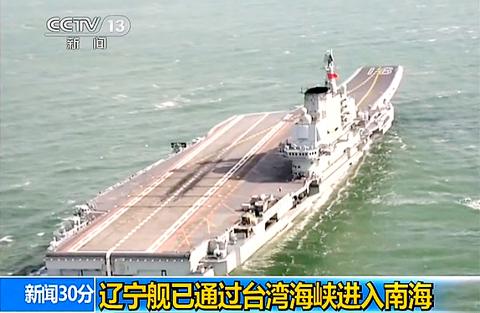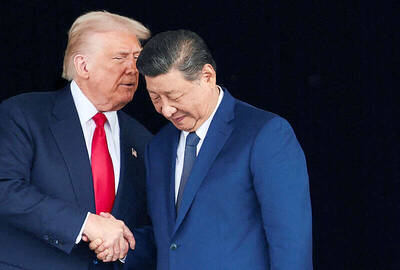The Ministry of National Defense yesterday confirmed that the Chinese aircraft carrier Liaoning passed through the Taiwan Strait yesterday morning — without crossing its median line — en route to the South China Sea, reiterating that the ministry had monitored the entire passage.
The voyage has drawn attention from Taiwan’s military and the international community amid rising tension over China’s demarcation of an air defense identification zone (ADIZ) in the East China Sea on Saturday.
Beijing’s East China Sea ADIZ overlaps with those of Japan, Taiwan and South Korea in a region marked by territorial disputes over the Diaoyutai Islands, claimed by Taiwan, China and Japan, and Ieodo, a South Korean-controlled submerged rock, which China also claims.

Photo: CNA
The carrier entered Taiwan’s ADIZ at about 10:30am on Wednesday and maintained a course approximately 14 nautical miles (26km) west of the median line of the Taiwan Strait before leaving Taiwan’s ADIZ at about 4am yesterday morning, ministry spokesman Major General David Lo (羅紹和) said.
“Taiwan’s surveillance and reconnaissance system, as well as several naval vessels and air force fighter jets, monitored the fleet’s entire passage through the Strait,” Lo said.
China’s Xinhua news agency reported early yesterday morning that the Liaoning, escorted by two guided missile destroyers, the Shenyang and Shijiazhuang, and two guided missile frigates, the Yantai and Weifang, had passed through the Strait on its way to a training mission in the South China Sea.
The voyage through the Strait took about 10 hours, the agency reported, adding that the Liaoning, China’s first and only aircraft carrier, left its home port of Qingdao in Shandong Province on Tuesday for a scientific and training mission.
The Liaoning, bought from Ukraine and refurbished in China, was commissioned last year and has been sent to the South China Sea for the first time.
Responding to the situation, Democratic Progressive Party Legislator Tsai Huang-liang (蔡煌瑯) yesterday urged President Ma Ying-jeou (馬英九) to lodge a protest with Beijing.
“Otherwise, the Taiwan Strait will become a Chinese inland sea in the future,” Tsai said, adding that Taiwan should side with its democratic allies over the situation.
Chinese Nationalist Party (KMT) Legislator Lin Yu-fang (林郁方) said China’s decision to send the carrier through the Taiwan Strait instead of cruising along Taiwan’s east coast hinted at Beijing’s backpedaling from its previously hawkish position on the ADIZ issue.

CALL FOR SUPPORT: President William Lai called on lawmakers across party lines to ensure the livelihood of Taiwanese and that national security is protected President William Lai (賴清德) yesterday called for bipartisan support for Taiwan’s investment in self-defense capabilities at the christening and launch of two coast guard vessels at CSBC Corp, Taiwan’s (台灣國際造船) shipyard in Kaohsiung. The Taipei (台北) is the fourth and final ship of the Chiayi-class offshore patrol vessels, and the Siraya (西拉雅) is the Coast Guard Administration’s (CGA) first-ever ocean patrol vessel, the government said. The Taipei is the fourth and final ship of the Chiayi-class offshore patrol vessels with a displacement of about 4,000 tonnes, Lai said. This ship class was ordered as a result of former president Tsai Ing-wen’s (蔡英文) 2018

‘SECRETS’: While saying China would not attack during his presidency, Donald Trump declined to say how Washington would respond if Beijing were to take military action US President Donald Trump said that China would not take military action against Taiwan while he is president, as the Chinese leaders “know the consequences.” Trump made the statement during an interview on CBS’ 60 Minutes program that aired on Sunday, a few days after his meeting with Chinese President Xi Jinping (習近平) in South Korea. “He [Xi] has openly said, and his people have openly said at meetings, ‘we would never do anything while President Trump is president,’ because they know the consequences,” Trump said in the interview. However, he repeatedly declined to say exactly how Washington would respond in

WARFARE: All sectors of society should recognize, unite, and collectively resist and condemn Beijing’s cross-border suppression, MAC Minister Chiu Chui-cheng said The number of Taiwanese detained because of legal affairs by Chinese authorities has tripled this year, as Beijing intensified its intimidation and division of Taiwanese by combining lawfare and cognitive warfare, the Mainland Affairs Council (MAC) said yesterday. MAC Minister Chiu Chui-cheng (邱垂正) made the statement in response to questions by Democratic Progressive Party (DPP) Legislator Puma Shen (沈柏洋) about the government’s response to counter Chinese public opinion warfare, lawfare and psychological warfare. Shen said he is also being investigated by China for promoting “Taiwanese independence.” He was referring to a report published on Tuesday last week by China’s state-run Xinhua news agency,

‘ADDITIONAL CONDITION’: Taiwan will work with like-minded countries to protect its right to participate in next year’s meeting, the foreign ministry said The US will “continue to press China for security arrangements and protocols that safeguard all participants when attending APEC meetings in China,” a US Department of State spokesperson said yesterday, after Beijing suggested that members must adhere to its “one China principle” to participate. “The United States insists on the full and equal participation of all APEC member economies — including Taiwan — consistent with APEC’s guidelines, rules and established practice, as affirmed by China in its offer to host in 2026,” the unnamed spokesperson said in response to media queries about China putting a “one China” principle condition on Taiwan’s